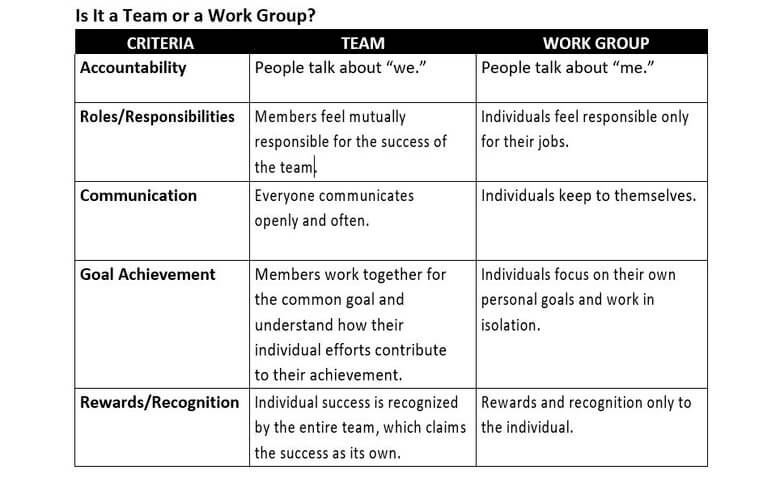By
Rose Polchin
|
Date Published: March 31, 2020 - Last Updated July 20, 2020
|
Comments
 “Focusing a group of individuals on a common goal, helping them to succeed, celebrating their successes, and, most importantly, connecting their performance to the bigger picture—this is what teams are all about.”
“Focusing a group of individuals on a common goal, helping them to succeed, celebrating their successes, and, most importantly, connecting their performance to the bigger picture—this is what teams are all about.”
In a time of significant change, when the way we work, how we work, and where we work requires us to learn how to more successfully navigate uncertainty, operating as a cohesive team is essential. Working teamwork in times of change becomes even more critical to our ability to serve customers, ensure our employees are engaged, and deliver results.
So, what is a team? It’s a simple question, but one that is seldom asked. A lot of folks assume that they’re part of a team without giving much thought as to what that really means or whether their team actually is a team.
Let’s start with a definition:
“A team is a group of people with complementary skills who are committed to a common purpose, performance goals and approach for which they hold themselves mutually accountable” - The Wisdom of Teams: Creating the High-Performance Organization by Jon Katzenbach and Douglas Smith.
Why are teams a natural “fit” for contact centers today? Consider the goals for which the contact center is held accountable— service level, quality, first-contact resolution, productivity, sales, customer satisfaction, etc. While it’s true that each individual has an impact on the outcome(s), it is the collective effort that allows the contact center to be successful.
Teams are a means to an end, and if they are developed effectively, the team’s average performance will exceed that of an individual working in a non-team environment. Besides higher performance, there are many other benefits, as well. For instance, team membership can:
- Create a sense of belonging and purpose for its individual members.
- Allow individuals to experience successes they may not have been able to do on their own.
- Help individuals see the bigger picture.
- Inspire individuals to perform at higher levels for the collective good.
What’s in a Name?
Once you’re aware of the power of teams, it’s important to ensure that what you have truly is a “team,” and not just in name alone. Sitting a bunch of agents together or telling them that they’re a team doesn’t make it so.
The chart below lists the criteria that distinguish a team from a work group. Keep in mind that sometimes a work group is the appropriate structure for the task or project at hand:

The Three Types of Teams
There are three different types of teams:
Teams that make recommendations. These teams may be cross-functional in nature, have very specific tasks or projects to complete, and will generally disband once the goal is achieved. An example would be a task force or team formed to select a new quality monitoring and recording system.
Teams that make or do things. These teams are generally near the frontline or on it. In most cases, the work is ongoing so there are no completion dates. However, there may be specific initiatives or process improvements that have targeted deadlines. These types of teams require systems and supporting improvements that have targeted deadlines. They also require systems and supporting processes to be in place because there is a relentless focus on performance and continuous improvement.
Teams that run things. These teams include managers, supervisors and team leaders. For these individuals to become a team, they must have a distinctive purpose that is specific to the team and that requires its members to accomplish goals beyond individual end products.
Contact center Team Success Factors
You may have all three types of teams in your contact center. In this article, we’ll focus on the contact center team, which is a team that “makes or does things.”
The following are seven success factors—each with an example for this type of team:
1. Set clear goals and standards and ensure that all team members understand the team’s purpose.
Example: A team goal may be to increase the accuracy of contact type logging from 50 percent to 80 percent within 60 days, without a drop in service level or an increase in handling time
Purpose: To assist in understanding the reasons why customers call, which will help to determine the most frequent and urgent reasons for contact. This data can then be used to focus on improving processes, creating better FAQs, looking at self-service options, providing better forecast data for better staffing, making improvements to scripts, and providing the marketing department with insights into customer needs. The end result will be more satisfied customers, more efficient operations, and potentially fewer calls about problems.
2. Provide a mechanism to assess progress toward goal achievement.
Example: The QA group measures the team’s progress by taking a random sample of recorded calls, screenshots, and email, and then matches the sample to contact type logged.
3. Establish a process to celebrate, communicate, and recognize progress toward goals and achievement of goals.
Example: Each day, the QA group posts the accuracy rate on the company intranet, as well as on “goal thermometers” posted around the contact center
4. Celebrate every movement of 10 percent
Example: Achieving the 80 percent goal is celebrated with a fun lunchtime outing for everyone.
5. Ensure that teams have the skills, knowledge, and abilities to successfully achieve the goals.
Example: Contact type codes and definitions are reviewed during lunchtime learning sessions that each agent is invited to attend in the two weeks prior to the official start date. QA and team leads coach individuals and make themselves available every day on every shift to answer any questions regarding contact type categories.
6. Ensure that there is individual and mutual accountability for performance and results.
Example: Each agent is responsible for attending a lunchtime learning session, asking for assistance when necessary, providing assistance to his or her peers, and celebrating successes.
7. Provide teams with support, recognition, and resources from management and the organization.
Example: Resources for training, coaching, rewards, and lunchtime learning sessions are provided by the company. The contact center has commitment and support from the organization, including marketing, senior management, training, HR, and IT to assist in making the initiative a success.
What’s Your Role in Team Development?
Focusing a group of individuals on a common goal, helping them to succeed, celebrating their successes, and, most importantly, connecting their performance to the bigger picture—this is what teams are all about.
As the leader of the contact center team, it’s your responsibility to help the group come together, establish goals and standards, determine how to capitalize on their individual strengths, and create an environment that embraces pride, enthusiasm, and ownership for their accomplishments.